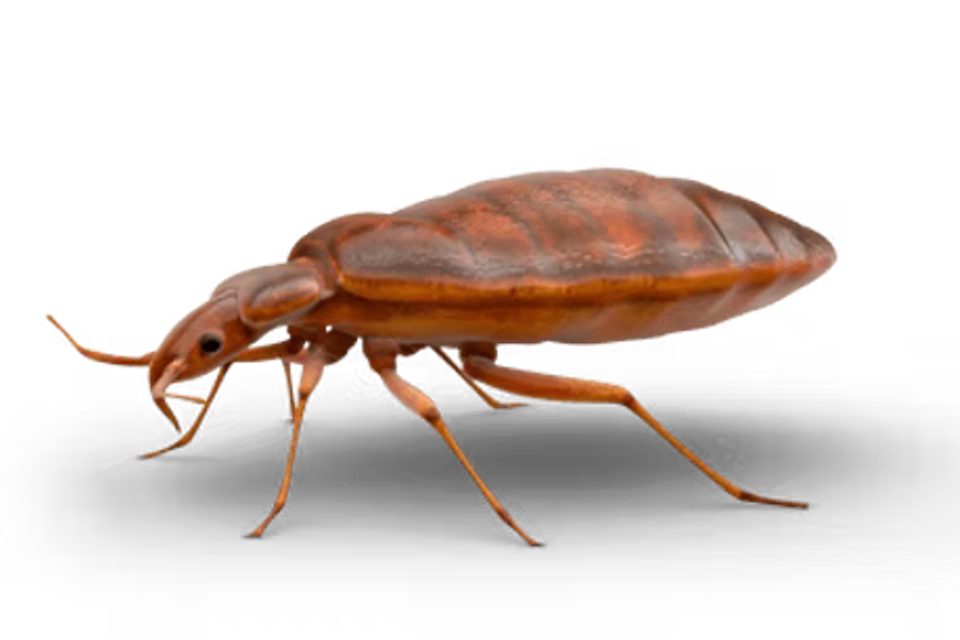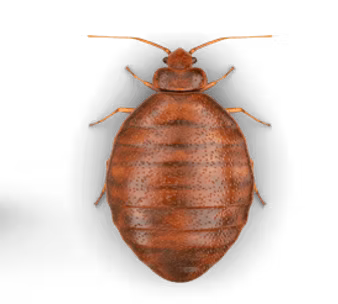
Common Bed Bug (Cimex Lectularius)
- Kingdom: Animalia
- Phylum: Arthropoda
- Class: Insecta
- Order: Hemiptera
- Suborder: Heteroptera
- Family: Cimicidae
Cimex Pilosellus and Cimex Pipistrella primarily infest bats. Haematosiphon Indora primarily infest poultry. The Bed Bug lives by hematophagy which means they live on the blood of humans and other warm blooded hosts.
BIOLOGY:
The Bed Bug is reddish-brown to mahogany colored. It has a flattened oval shaped, wingless body with piercing-sucking mouthparts. The microscopic hairs give them a banded appearance that often looks like an apple seed. The female Bed Bug lays two (2) eggs per day until she has laid about 200. At room temperature the eggs will hatch in six (6) to seventeen (17) days. The newly hatched nymphs are translucent and become browner as they molt and mature. The Bed Bug can be seen with the naked eye especially after they have gorged themselves with blood.
FEEDING HABITS:
Bed Bugs are mainly active at night with the peak feeding period just before dawn about an hour before sunrise. They will climb walls to the ceiling and jump down when they feel the wave of heat from humans or a warm blooded animal. Once Bed Bugs are attracted by warmth and the presence of carbon dioxide they pierce the skin with two (2) hollow tubes. With one tube the Bed Bug injects its saliva which contains anticoagulants and anesthetics, at the same time the other tube is withdrawing (sucking) blood from the host. Bed Bugs typically feed for about five (5) minutes then retreat to their hiding places. The person who is bitten usually cannot feel the bite until minutes or even hours later when they have an overwhelming desire to scratch the bitten areas.
REPRODUCTION:
All Bed Bugs mate by a process that is called traumatic insemination. Instead of inserting their genitalia into the female’s reproductive tract, that is typical in copulation, the males pierce the females with hypodermic genitalia and ejaculate into their body cavity. Feeding Habits and Reproduction are mentioned here to point out that Bed Bugs have all the known prerequisites for being capable of transmitting diseases from one host to another, i.e., one person to another. In laboratory testing Bed Bugs have been found to carry the “causative agents” for several diseases such as anthrax, plague, tularemia, yellow fever, relapsing fever and typhus. However, there are no known cases of Bed Bugs passing diseases, thus making the Bed Bug less dangerous than the flea.
Anaphylactoid reactions produced by the injection of serum and other proteins in the saliva of Bed Bugs show that it is possible that a person could suffer anaphylactic shock. The possibility of anaphylactic shock is increased with sustained Bed Bug feeding, which also may lead to anemia.
BITE INSPECTION:
Bites on humans consist of a raised red bump or a flat welt, with obvious itching marks on and around the bite. Most Bed Bug bites are almost indistinguishable from a mosquito bite except they last longer on the skin.
Bed Bug bites do not have a centered “red dot” appearing bite like fleas. Fleas also bite in “threes” referred to as colloquialism, i.e., three dots in a row. However, the arrangement of bites from a Bed Bug may be numerous because it may be searching for a vein. Once the vein is found there may be a single bite or multiple bites that follow a linear pattern marking the path of the blood vessel closest to the surface of the skin. To further the problem, 50% of all bites leave no visible signs on people, thus making it difficult to identify and eliminate infestations if there is no apparent evidence in the surrounding environment.
MEDICAL NOTE:
For relief of visible bites or an area that is itching with no visible bite, apply hot water at an estimated temperature of 120 degrees. Some believe that heat overwhelms the nerve endings that signal an itch, they believe that heat neutralizes the chemical that is causing the inflammation, or that heat triggers the body to release histamine which causes the histamine in the affected area to decrease.

